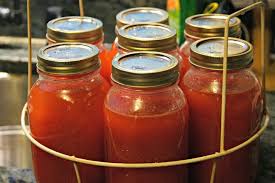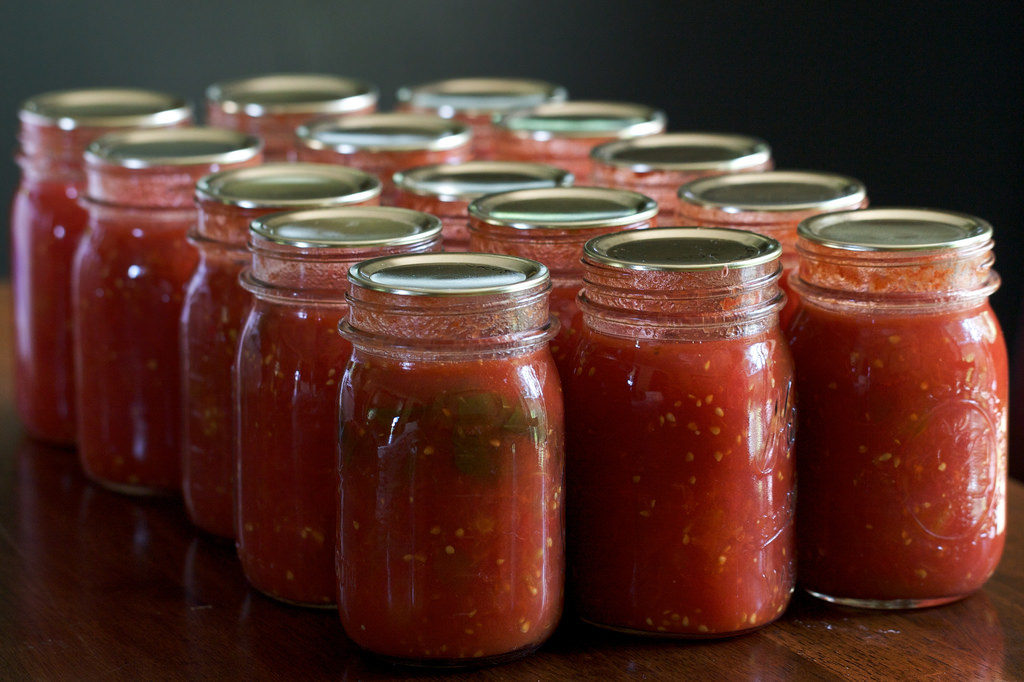Canning tomato juice at home is a simple way to supply your family with healthy, wholesome juice. Home canned tomato juice is a low sodium and low cost alternative to V8. You can also use it easily in many recipes calling for tomato sauce or whole tomatoes. Canning tomato juice gives you a convenient base for soups, stews, sauces and curries.
Making Tomato Juice
The first step to canning tomato juice is preparing the juice. The best juice comes from farm fresh tomatoes. Choose large, firm tomatoes with no blemishes. For a fun twist, try canning tomato juice from colorful tomatoes like the Orange King, a variety that thrives in cool climates. If you are canning tomato juice from a green variety like Green Zebras you’ll need to add extra citric acid, lemon juice or vinegar to the juice before canning, since these varieties are low in acid.
RELATED: The Importance of Acidifying Canned Tomatoes
Here are a few great recipes for making tomato juice.
Blender Tomato Juice Recipe
The simplest way to make tomato juice is to simply toss some tomatoes in a blender. You can add other veggies in (if you do this, be sure to use a pressure canner due to the low acidity of the vegetables) to make a V8 style juice.
Homemade Spicy Tomato Juice
A more traditional method is to cook the tomatoes, with or without their skins. You can gently mash the tomatoes with a wooden spoon, and then run the tomatoes through a sieve or strainer to produce a nice juice. Add a little water to the tomatoes as they are cooking. You can boil them a little longer to make a thicker juice, or add more water for a thinner juice.
You don’t need a recipe for spicy tomato juice. Simply add your favorite peppers, jalapenos, serranos or even habaneros if you’re feeling bold to the boiling tomatoes. You can use an easy shortcut to delicious spicy juice by adding a dash of your best hot sauce to just before canning.
Canning Tomato Juice: Skins or No Skins?
Removing the Skins Before Canning Tomato Juice
Most canning tomato juice recipes call for removing the skins. These is easily done by boiling them for thirty seconds and them dipping them in ice water.
Canning Tomato Juice with Skins Intact Gives a Nutritional Boost
The skin of a tomato is full of vitamins and nutrients and those all-important anti-oxidants. If you are canning tomato juice from home-grown tomatoes or organic tomatoes, leave the skins on. You can toss the entire (well-washed) tomatoes right into the blender, or boil them with skins on and then run the cooked tomatoes through a strainer before canning the juice.

Image courtesy of thecreativebite.com
Canning Tomato Juice 2 Ways
Canning tomato juice is just like canning whole or crushed tomatoes. There are two options:
1. Canning Tomato Juice with a Pressure Canner
Canning tomato juice with a pressure canner is the method recommended by the FDA and the National Center for Home Food Preservation. Check out their handy time tables for pressure canning tomato juice here.
Using a pressure canner reduces the amount of time you must process the tomato juice, which leaves more of the vitamins and nutrients intact.
2. Canning Tomato Juice with a Boiling Water Bath
Water bath canning has been used for canning tomatoes and other foods for about 200 years. However, due to the variable amounts of acid in tomatoes, there is a small risk of botulism when using this method. This risk can be easily mitigated by acidifying the tomato juice prior to canning and processing the juice for a sufficient amount of time. You should always boil the tomato juice and pack it into the jars hot. Experts recommend processing for 35 minutes for pints and 40 minutes for quarts when canning tomato juice.
Extended Reading
The Complete Guide to Canning Tomatoes
Looking for the best homemade tomato juice recipe? Look no further, here it is!

